 Research Article
Research Article
Momentum of Re-Acidification Over Time in Lime Reclaimed Acidic Soil of Bako Area in Soybean (Glycine max L.) Production, Western Ethiopia
Derib Kifle* and Geremew Taye
Ethiopian Institute of Agricultural Research, Holeta Agricultural Research Center, Ethiopia
Derib Kifle, Ethiopian Institute of Agricultural Research, Holeta Agricultural Research Center, PO box 31, Ethiopia. Poland.
Received Date: April 26, 2022; Published Date: May 24, 2022
Abstract
On station a permanent plot experiment was conducted at Bako during 2012-2015 cropping season to investigate soil acidity and P availability change over time in response to the application of different rates of agricultural lime to determine the optimal level and frequency of lime application in improving soybean productivity and selected chemical properties of the soil. Five levels of lime (0, 2.3, 3.45, 4.6, and 5.75 t/ha) were laid out in Randomized Complete Block Design with three replications. The results of the study showed that the highest grain yield was recorded from the use of slightly optimal 5.75 t/ha (125% recommended rate) level of lime. Similarly, grain yield was significantly affected by the cropping season where the maximum mean value was obtained in the second cropping season, improving soybean productivity by 148% compared to the control. In the other standpoint, the soil laboratory analytical results after harvest showed that the highest soil pH (6.22) was recorded from the application of optimal level (5.75 t/ha) of lime. Conversely, the exchangeable acidity was significantly reduced to 0.52 cmol(+)/kg that improved the potential acidity level of the soil by 196%. The highest soil available P (26.39 mg/kg of soil) was recorded from the plots treated with 4.6 tons/ha of lime in the second cropping season. The grain yield data and soil test results showed that both attributes were affected by the cropping season where optimal values were recorded during the second cropping season after lime application, which afterward witnessed a decreasing tendency starting from the third year after lime application indicating that the subsequent liming intervention should be made after the third year to sustain soil and soybean productivity of the area.
Keywords: Available P; Exchangeable acidity; Optimal level; Re-liming; Soil pH
Introduction
Food insecurity and malnutrition are among the urgent challenges that developing countries face these days. The major staple food crop of most developing Sub Saharan African Countries, maize, contains low protein (5.2-13.7 %) [1]. The challenges are acute in Ethiopia and relatively more serious in rural than urban areas, mainly because of a low level of understanding of a balanced diet and lack of capacity to purchase animal source proteins.
Soybean is a multipurpose crop, which can be used for a variety of purposes including preparation of different kinds of soybean foods, animal feed, soy milk, raw materials for the processing industry, and it counter-effects the depletion of plant nutrients in the soil resulting from continuous mono-cropping of cereals, especially maize and sorghum, thereby contributing to increasing soy fertility [2]. There is also a potential to intercrop soybeans with long stem crops such as maize and sugarcane [3].
Producing and consuming more soy would improve the situation as soy provides a nutritious combination of both calorie and protein intake: it is the most nutritionally rich crop, as its dry seed contains the highest protein and oil content among grain legumes (40 to 42% protein) with a good balance of essential amino acids and has 18-20% oil on a dry seed weight basis. It is a cheap and rich source of protein for poor farmers, who have less access to animal source protein, because of their low purchasing capacity [4].
However, Soybean’s productivity is low in Ethiopia with a national average yield of 1.998 tons/ha, which is below the global average 2.31ton/ha [5]. The low national yield could be attributed to various reasons, among which lack of improved varieties, improved agronomic practices, and acid soil infertility caused by leaching of exchangeable cations (Ca2+, Mg2+, K+) and accumulation of high concentration of Al are the main factors that adversely affect the soybean production in the country [6]. In acid soils, the availability of phosphorus, microbial activity, and biological nitrogen fixation are reduced, which in turn affects soybean performance through reduced photosynthesis and early root development, leading to low yields [7,8].
Increased soil acidity causes solubilization of Al3+, which is the primary source of toxicity to plants at pH below 5.5, and deficiencies of P, Ca, Mg, N, K and micronutrients [9,10]. Among these constraints, toxicity and P deficiency are the most important ones, due to their ubiquitous existence and overwhelming impact on plant growth [9], which limits crop growth and development that adversely affects crop production. For crop production, soil acidity is a complex of numerous factors involving nutrient deficiencies and toxicity, low activity of beneficial microorganisms, and reduced plant root growth, which limits the absorption of nutrients and water [11]. However, Al3+ toxicity is one of the major limiting factors for soybean production on acid soils by inhibiting root cell division and elongation, thereby reducing water and nutrient uptake, poor nodulation or mycorrhizal infections [12], consequently leading to poor growth of soybean and its yields.
Such problematic soils require careful soil fertility management practices to enhance soybean production and productivity, most specifically the application of agricultural lime. Limes are materials containing carbonates, oxides, or hydroxides that are important to amend soil acidity to raise soil pH and neutralize toxic elements in the soil. Studies have shown that apart from reducing the acidity of the soil by counteracting the effects of excess H+ and Al3+ ions, liming also has several other benefits including its ability to reduce the toxicity effects of some micro elements by lowering their concentrations; increasing the availability of plant nutrients, such as Ca, P, Mo, and Mg in the soil, and reducing the solubility and leaching of heavy metals [13].
The rate and frequency at which lime is applied depends on the initial pH value of the soil and lime quality, soil type, and soil drainage. One of the principal soil characteristics related to its type, which is responsible for determining the rate and frequency of liming, is cation exchange capacity (CEC). Soils with a high clay and organic matter content (greater reserve acidity) will require greater amounts of lime to neutralize acidity than a sandy soil lower in clay content and organic matter (lower reserve acidity) given that each soil has the same pH [13]. Soil pH declines faster in sandy (low CEC) soils than in soils with moderate to high clay content.
A soil that is poorly drained requires less frequent liming than a well-drained soil because of the reduced leaching of basic cations under poorly drained conditions [14]. Thus, the purpose of the present study was to observe the magnitude of lime effect on the yield of soybean and to investigate the soil acidity and P availability change over time in response to the application of different rates of agricultural lime
Materials and methods
Description of the study area
The study was conducted in Bako Tibe District, West Shewa zone, Oromia regional state, Ethiopia. The District is situated at a distance of 250km West of Addis Ababa. Geographically, the study site is located at a latitude of 9° N and longitude of 37° E and a is found at an altitude of 1650 m above sea level (Figure 1). Agro-climatically, the location has been characterized as warm humid mid highlands with annual mean minimum and maximum air temperatures of 13.5 and 29.7 °C, respectively. The area received average annual rainfall of 1425 mm (2012), 886 mm (2013), and 1431mm (2014) with maximum precipitation being received in the months of May to August, in which the monthly distributions of the rainfall were not similar through the cropping seasons. The soil of the experimental site was reddish-brown nitisol, which is strongly acidic in reaction with a pH range of 5.0-5.4 according to the rating by [15]. The area is a mixed farming zone based on rain fed and is characterized by low productivity, although it is one of the most important potential soybeans (Glycine max L.) growing belts in Ethiopia. The other major crops produced in the District are maize (Zea mays L.), finger millet (Eleusine coronata), common bean (phoseolus vulgaris L.) and tef (Erograstis tef).
Figure 1: Map of the study area.
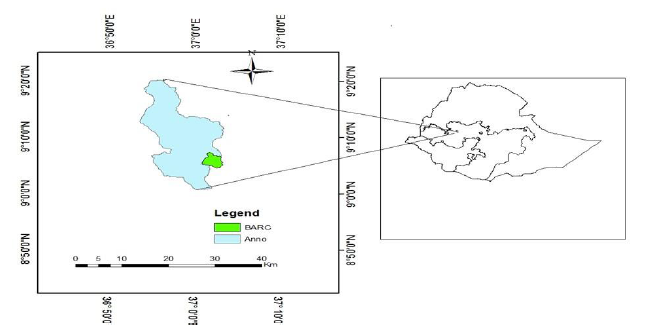
Soil sampling and analysis
Soil samples (0–20 cm) were collected from the whole experimental field before lime application and from every experimental unit after each harvesting season randomly in a zigzag pattern using an auger and core sampler. Soil samples were air-dried; gravel and non-decayed plant debris were removed and were ground to pass through a 2mm and 0.5 mm screens prior to analysis. Soil pH was determined potentiometrically using a pH meter with a combined glass electrode in a 1:2.5 soil to water supernatant suspension [16]. The base titration method, which involves saturation of the soil sample with 1M KCl solution and titrating with sodium hydroxide, was employed to determine the exchangeable acidity as described by [17]. Available soil phosphorus was extracted by the Bray II procedure [18] and determined calorimetrically by spectrophotometer.
Lime rating and fertilization
The amount of lime was determined based on the soil’s exchangeable acidity (Al+3 plus H+1) and bulk density with in 0.20m depth of the soil. It was assumed that one mole of exchangeable acidity would be neutralized by an equivalent mole of CaCO3 [19] for liming acid mineral soils. Soil acidity ameliorant used in the experiment was calcite limestone of 95 CCE (Calcium Carbonate Equivalent) and fineness of 90 microns, while, the fertilizer source was TSP (Triple Super Phosphate). The recommended rates of lime and P were 4.6 t/ha and 46 kg/ha, respectively.

Where: LR- Lime requirement (kg ha-1), Ac- Exchangeable acidity (cmol(+)/kg soil), 0.2- plough depth, BD- Bulk density.
Experimental design and procedures
The experiment comprised four levels of lime (0, 2.3, 3.45, 4.6, and 5.75 t/ha) which represented 0, 50%, 75%, 100% and 125% recommended amount of lime respectively, constituting a total of five treatments which was laid out in RCBD with three replications. The linear model for one-factor RCBD:
Yij = μ + τi + βj + εij where, Yij = the observation on the jth block and the ith treatment; μ = common mean effect; τi = effect of treatment i; βj = effect of block j; and εij = experiment error for treatments i in block j.
Lime was surface applied and incorporated into the soil by hand 30 days before planting. The test crop was a soybean variety of ‘Boneya’ recommended for Western Oromia Agro ecological zone which was planted at intra-and inter-spacing of 40cm x 5 cm in plot area of 16m2 after the P fertilizer had been applied per row and mixed with soil. Net plot area of 12.8m2 was used for crop data collection at harvesting. Harvesting was done when 95% of the plants reached harvestable maturity. Seed yield was weighed and adjusted to 10% moisture content standard as recommended by Biru [20] according to the formula; Adjusted yield (g/plot) = Measured yield × (100 – sample moisture content/100 – standard moisture content).
Data analysis
Data were analyzed using SAS version 9.2 [21] computer software and were subjected to ANOVA to determine significant differences among factors and their interactions. Means were separated using LSD test. For all analyzed parameters, P< 0.05 was interpreted as statistically significant.
Results and Discussion
Selected soil properties before sowing
According to the laboratory analytical results, the soil of the study area was sandy clay loam in texture, very strongly acidic in reaction as rated by [22], and low in available P which is probably attributed to the high P fixing capacity of the soil in the area (Table1). Finally, the acidic nature of the soil which can be toxic to plants and hence can depress their growth and the lower proportion of P that can potentially affect crop performance signifies that the soil needs acidity adjustment to sustain crop production and productivity.
Table 1: Some physical and chemical properties of the soil of experimental site.

Effects of lime and cropping season on soybean grain yield
The interaction of lime application by cropping season was significantly different for seed yield where the maximum mean grain yield of 3.87 t/ha-1 was obtained in the second cropping season improving soybean productivity by 148% compared to the control (Figure 2). The lowest seed yield, which was not significantly different from the others regarding the rate of lime applied, was obtained during the fourth cropping season after lime application. Other than the minimum lime rate applied, seed yield during the second production season after lime application was highly significant compared to the third and fourth cropping year after lime application that showed a decreasing tendency of soybean yield over time after lime amendment. Treatment without lime produced significantly the lowest seed yield in each cropping season. This tendency of yield decrease beyond the application of lime might be attributed to the decline of lime reaction through time and the imbalance of P with other nutrients due to the altered nutrient availability to growing plants [23]. This result agrees with the finding of Getachew et al. [24] that describes the phenomenon of crop yield decline over years of liming may indicate re acidification of the soil, which necessitates re-liming of the soil.
Figure 2: Grain yield is affected by the interaction of liming and cropping season. LR= lime rate (t/ha). Each point represents the mean of three replicated treatments and error bars indicate ± SE.
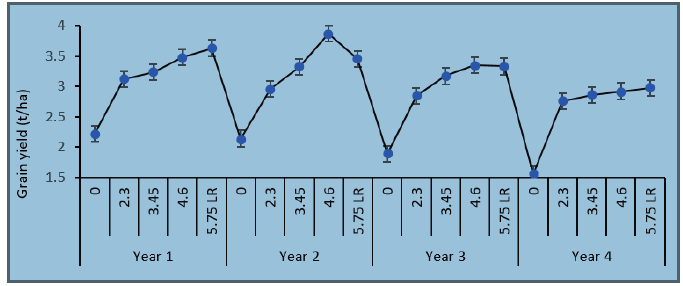
Soil acidity indices and available P change over time in lime reclaimed soil
Soil pH: The laboratory analytical results showed that all tested soil pH was affected by the cropping season in which the highest record for these properties was obtained during the second and third cropping season after lime application. Certainly, most of the records for this parameter showed sharp decreasing tendency after the third year of lime application. In all seasons, the application of lime alone recorded a higher value for most of the soil characteristics (Figure 3). This agrees with the observation of Alemayehu et al. [25] who remarked that the carry-over effect of conditioning acid soil with lime is better than its external fertilization in maintaining proper soil process and health in the long run. The lowest value of pH which was equivalent to the threshold record obtained from the minimum dose of lime (2.3 t/ha) during the fourth cropping season that explains how soil pH changes over time if soils are continuously cropped but not limed.
Figure 3: Grain yield is affected by the interaction of liming and cropping season. LR= lime rate (t/ha). Each point represents the mean of three replicated treatments and error bars indicate ± SE.
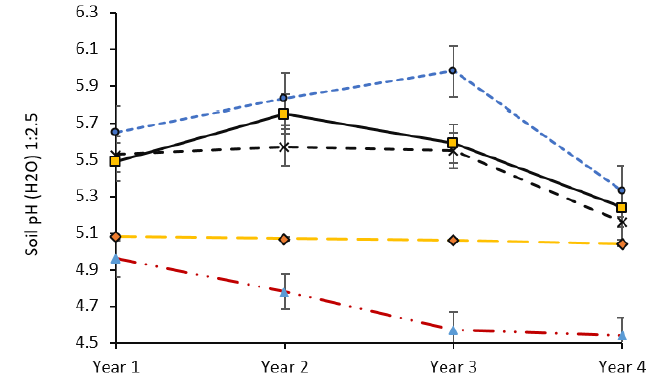
Soil exchangeable acidity and aluminum
Application of lime and its residual effect highly decreased the exchangeable acidity and exchangeable Al+3 as the level of applied lime rate increased (Figure 4). The present findings agree with Malhi et al. [26] who reported that application of lime at the rate of 2 t/ha significantly increased topsoil pH values from 4.6 to 6.0 while exchangeable acidity and Al+3 had significantly reduced in the first 3 cropping seasons which indicated that lime application had significantly (P<0.05) decreased soil acidity sharply in the first year and thereafter slightly amplified over years.
On the whole, the liming treatments reduced the soil exchangeable acidity of the experimental field in all seasons (Figure 5) that reduced the initial value (2.29 cmol(+)/kg) by 54.7% at the minimum during the last (fourth) cropping season. This was substantiated by the observation of Athanase [14] that suggests that it is rarely necessary to lime acid soil more frequently than every 3 years. The experimental unit that received 5.75 t/ha of lime during the third second cropping season was most effective in reducing exchangeable acidity that recorded 0.42 cmol(+)/kg reducing value by 266% compared to the control.
Soil available phosphorus
The results of this study showed that amending acidic soil with lime resulted in a significant increase of available P (26.39 mg kg-1 of soil) markedly at 2013 cropping season in which application of the recommended rate (4.6 t/ha) of lime increased the available P content of the soil by 190% over the control (Figure 5). The postharvest seasons of the second and third year in which application of the highest rate (5.75 t/ha) of lime increased the available P content of the soil by 156% over the control (Figure 5). The result of this study is in concomitance with the findings of Anetor & Akinrinde [27] who reported that the mean P concentration in limed soil sample is higher (20.85 ppm) than before liming (9.14 ppm), which clearly shows highly significant effects of soil acidity adjustment on P availability. The increment of the available P content of the soils with increasing lime rate may be attributed to increasing pH due to liming that could release the unavailable P which was previously fixed with Al and Fe at low soil pH conditions. Therefore, agricultural lime added to soil is a profitable soil additive and it hydrolyzes Al and Fe ions that precipitated with P, releasing the tied-up P into the soil solution, consequently rendering the phosphate ion available for plant uptake.
Figure 4: Soil exchangeable acidity as affected by the interaction of liming and cropping season. LR= lime rate (t/ha). Each point represents the mean of three replicated treatments and error bars indicate ± SE.
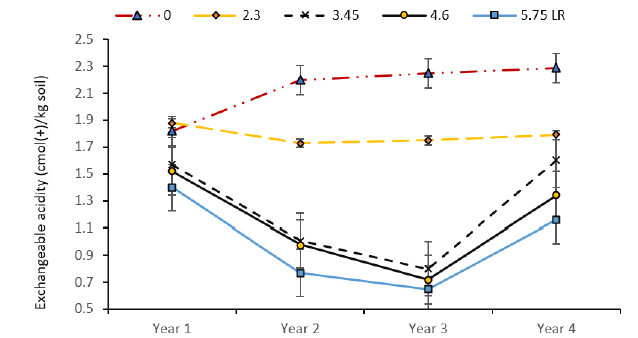
Figure 5: Soil available phosphorus as affected by liming in different cropping season, LR= lime rate (t/ha). Each point represents the mean of three replicated treatments and error bars indicate ± SE.
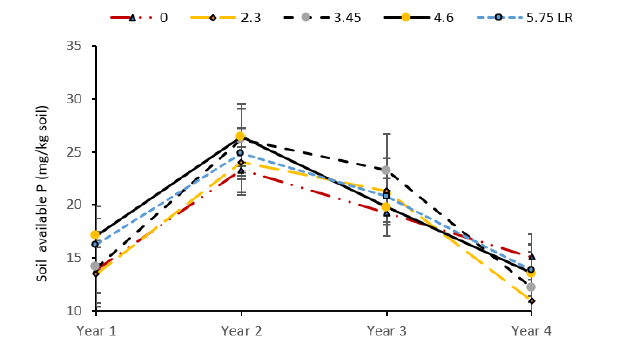
Liming and thus raising the pH of acidic soil across different land use systems generally provide more favorable environments for microbial activities and possibly results in net mineralization of soil organic P [28]. In another perspective, the other reason for the increase of soil P might be a result of the residual effects of the applied P fertilizer in every cropping season because of its low mobility in the soil. This follows the observation of Nekesa et al. [29] that asserted liming can have a P-sparing effect, which decreases the fixation of inorganic P by soil colloids and stimulates the uptake of P by plants. The strength of adsorption of phosphate onto soil surface is affected by pH and the effect depends on the predominant clay minerals and types of organic matter in soil.
Generally, P adsorption is the weakest at neutral pH and increases with increasing acidity where liming of acidic soils reduces the P sorption, thus increasing its availability. This fact is more emphasized in [24,30-32] reports also stated that liming increased soil pH and P availability, where the Ca2+ and Mg2+ in lime displace Al3+, Fe2+ and H+ ions from the soil sorption sites resulting in reduction of soil acidity and P fixation in soils that have been depleted. In general, for acid soils with a low initial pH, it can be expected that the extractable P increases after lime application [33-37].
Conclusion
In the final analysis, application of lime reduced soil acidity and increased available P, in which the higher dose of this soil conditioner increased and maintained longer residual effects on soil pH, exchangeable acidity, exchangeable A l 3 + available P and grain yield than lower ones. The results of the current study showed that all measured soil properties and seed yield of soybean were affected by the cropping season in which the highest values for these variables were recorded during the second cropping season after lime application. Indeed, most of the records for these parameters showed a decreasing tendency in the third and fourth cropping season even though the soil acidity level didn’t revert to its threshold level at the end. Thus, it can be inferred from the result of this study that the subsequent liming intervention should at least be made at every three years intervals of the first lime application period to keep soil acidity and soil nutrient level in check for sustainable soybean production in such acidic soil areas.
Acknowledgment
The authors would like to appreciate the committed personal participation of the staff members of the soil Fertility Improvement and Soil and Water Conservation team of Bako Agricultural Research Center in attending the experiment on the field, in data collection and monitoring the field work at the test site. The authors are also highly indebted to Oromia Agricultural Research Institute for providing financial support for the execution of the research.
Conflict of Interest
The authors had not declared any conflict of interests.
References
- Andy W, Abdullah T (2016) Effect of Lime Application on Soil Properties and soybean yield on tidal land. Indonesian Legumes and Tuber Crops Research Institute, Ji. Raya Kendalpayak KM 8, Malang, East Java, Indonesia.
- Hailegiorgis Biramo Allaro (2010) Export performance of oilseeds and its determinants in Ethiopia. Haramaya University, College of Agriculture and Environmental Science, Department of Agricultural Economics.
- Jagwe J, Owuor G (2004) Evaluating the marketing opportunities for soybean and its products in the East African countries of ASARECA: Kenya Report. International institute of Tropical Agriculture -FOODNET.
- Osho SM (1995) Soybean processing and utilization research at International Institute of Tropical Agriculture. Processing from SOYAFRICA’95: Johannesburg, South Africa, 4-5.
- CSA (Central Statistical Agency of Federal Democratic Republic of Ethiopia), 2000-2012. Annual report.
- Workneh B (2013) Liming Effects on Yield and Yield Attributes of Nitrogen fertilizer and Bradyrhizobia Inoculated Soybean (Glycine max L.) Grown in Acidic Soil at Jimma, South Western Ethiopia. Journal of Biology, Agriculture and Healthcare 3(7): 139-143.
- Amba AA, Agbo EB, Voncir N, Oyawoye MO (2011) Effect of phosphorus fertilizer on some soil chemical properties and nitrogen fixation of legumes at Bauchi. Continental Journal of Agricultural Science 5(1): 39-44.
- Kamara AY, Abaidoo R, Kwari J, Omoigui L (2008) Influence of phosphorus application on growth and yield of soybean genotypes in the tropical savannas of northeast Nigeria. Archives of Agronomy and Soil Science 53(5): 539 -552.
- Kariuki K, H Zhang, L Schroder, J Edwards, M Payton, et al. (2007) Hard red winter wheat cultivar responses to a pH and aluminum concentration gradient. Agronomy journal 99: 88-98.
- Mesfin A (2007) Nature and management of acid soils in Ethiopia. Addis Ababa, Ethiopia. 99 p.
- Fageria K, C Baligar (2008) Ameliorating soil acidity of tropical Oxisols by liming for sustainable crop production. Advances in agronomy 99: 345-399.
- Delhaize E, D Gruber, R Ryan (2007) The roles of organic anion permeases in aluminium resistance and mineral nutrition. Febs Letters 581: 2255-2262.
- Wijnands J, Biersteker EN (2009) Oil Seeds Business Opportunities Ethiopi. Food outlook.
- Athanase NV, Ruganzu J, Mugwe N, Rusanganwa AC (2013) Effects of Unburned Lime on Soil pH and Base Cations in Acidic Soil. Department of Natural Resource Management, Rwanda Agriculture Board (RAB).
- Jones JB (2003) Agronomic Hand-book: Management of Crops Soils and Their Fertility. Press LLC, Boca Raton, Florida, USA. 482p.
- Van Reeuwijk LP (1992) Procedures for Soil Analysis. 3rd Edition. International Soil Reference and Information Centre Wageningen (ISRIC). The Netherlands. P.O. Box 353.
- Rowell D (1994) Soil Science: Method and Applications. Addison, Wesley, England: Longman Scientific and Technical, Longman Group UK Limited.
- Bray RH, Kurtz, LT (1945) Determination of Total Organic and Available Phosphorus in soils. Soil Science 59: 39-45.
- Kamprath EJ (1984) Crop Response to lime in the tropics. In: Adams, F. (eds.) Soil Acidity and Liming. Agronomy Madison, Wisconsin USA 12: 349-368.
- Biru A (1979) Ababa, Agricultural Field Experiment Management manual. Part III, IAR (Institute of Agricultural research), Addis Ethiopia.
- SAS Institute (2004) SAS user’s guide. Release in version 9.2 ed. SAS Inst., Cary, NC. USA.
- Foth HD, Ellis BG (1997) Soil Fertility, second ed. Lewis Publishers.
- Gascho GJ, Parker MB (2001) Long-term liming effects on coastal plain soils and crops. Agronomy Journal. 93(6): 1305-1315.
- Derib K, Bobe B, Getachew B (2017) Nodulation and Grain Yield of Soybean and Selected Chemical Properties of the Soil as Affected by Liming at Bako Area Western Ethiopia. Journal of Natural Sciences Research 1(7): 11.
- Alemayehu K, Sheleme B, Schoenau J (2017) Fractionation and availability of phosphorus in acid soils of Hagereselam, under different rates of lime. Southern Ethiopia. Agric 4: 21.
- Malhi SS, Mumey G, Nyborg M, Ukrainetz H, Penney DC, et al. (1983) Longevity of liming in Western Canada: Soil pH, crop yield and economics. In: Date, R.A. (Ed), Plant soil interaction at low pH, Kluwer Acadamic Publishers, Amsterdam, pp. 703-710.
- Anetor MO, Akinrinde EA (2006) Response of Soybean (Glycine max ) to lime and phosphorus fertilizer treatments on an acidic Alfisol of Nigeria. Pakistan Journal of Nutrition 5(3): 286-293.
- Achalu C, Heluf G, Kibebew K, Abi T (2012) Effects of Liming on Acidity-Related Chemical Properties of Soils of Different Land Use Systems in Western Oromia Ethiopia. World Journal of Agricultural Sciences 8(6): 560-567.
- Nekesa AO, Okalebo JR, Othieno CO, Thuita MN, Bationo A, et al. (2011) The potential of increased maize and soybean production in uasin gishu district, Kenya, resulting from soil acidity amendment using minjingu phosphate rock and agricultural lime. In A. Bationo et al. (Eds.), Innovations as key to the green revolution in Africa.
- Geremew T, Bobe B, Lemma W (2020) Applications of lime and phosphorus fertilizer to malt barley for improved yield and soil acidity at Welmera district, Ethiopia. J Appl Sci Technol 11(2): 39-50.
- Hammond JP, Broadley MR, White PJ (2004) Genetic responses to phosphorus deficiency. Ann Bot 94(3): 323-332.
- Mullins G (2001) Phosphorus, agriculture and the environment. Virginia Cooperative Extension, Virginia State University, Publication No. 424-029.
- Temesgen D, Tolessa D, Ayalew A, Geremew T, Chelot Y, et al. (2017) Effect of lime and phosphorus fertilizer on acid soil properties and barley grain yield at Bedi in Western Ethiopia. Ethiopian Institute of Agricultural Research.
- Kisinyo PO, Gudu SO, Othieno CO (2012) Effects of lime phosphorus and rhizobia on Sesbaniasesban performance in a Western Kenyan acid soil. Afric J Agric 7(18): 2800-2809.
- Kochian V, A Hoekenga, A Pineros (2004) How do crop plants tolerate acid soils? Mechanisms of aluminum tolerance and phosphorous efficiency. Annu Rev Plant Biol 55: 459- 493.
- Mekonnen H, Kaleb K (2014) Trends in Soy Bean Trade in Ethiopia. Research Journal of Agriculture and Environmental Management 3(9): 477-484.
- Sanginga N (2003) Role of biological nitrogen fixation in legume based cropping systems: a case study of West Africa farming systems. Plant and Soil 252: 25-39.
-
Derib Kifle and Geremew Taye. Momentum of Re-Acidification Over Time in Lime Reclaimed Acidic Soil of Bako Area in Soybean (Glycine max L.) Production, Western Ethiopia. World J Agri & Soil Sci. 7(5): 2022. WJASS.MS.ID.000675.
-
Available P, Exchangeable acidity, Optimal level, Re-liming, Soil pH
-

This work is licensed under a Creative Commons Attribution-NonCommercial 4.0 International License.






